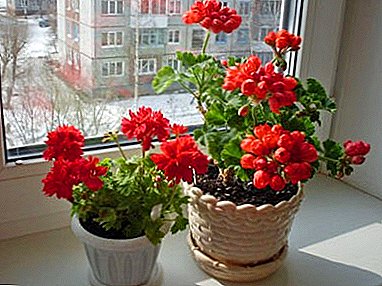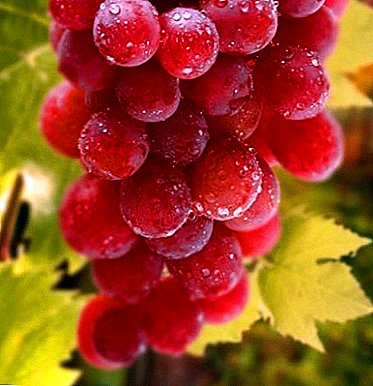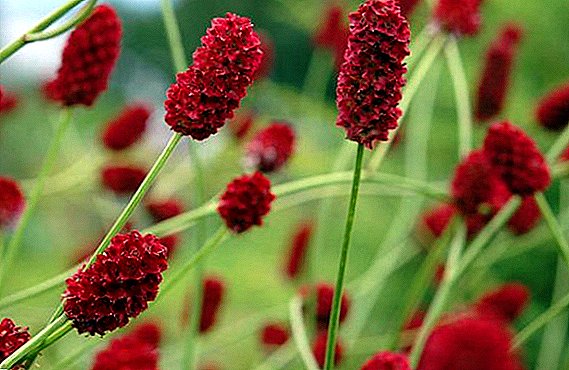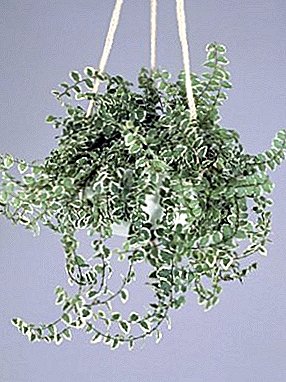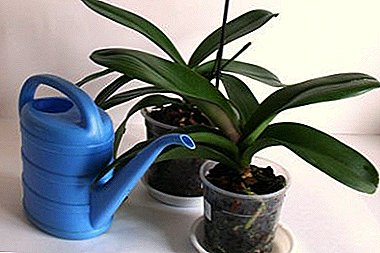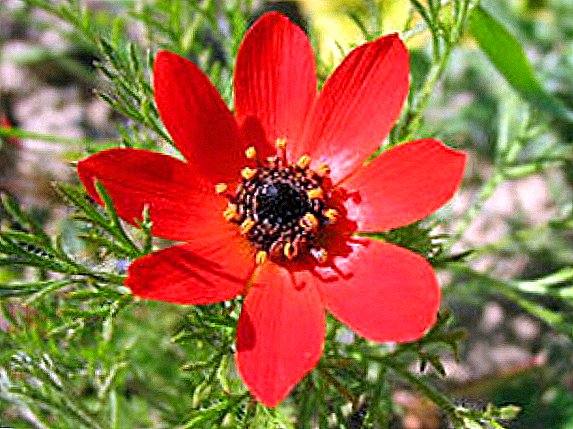 Adonis - a beautiful early-flowering perennial, which is not the last among the plants used in landscape design. It is also widely known for its medicinal qualities. Listed in the international Red Book due to systematic destruction.
Adonis - a beautiful early-flowering perennial, which is not the last among the plants used in landscape design. It is also widely known for its medicinal qualities. Listed in the international Red Book due to systematic destruction.
Description
Adonis - a unique plant, since it is possible to grow both perennial and annuals; belongs to the family of buttercups. It grows in the temperate climate of Europe and Asia. Regardless of the species, this flower creates low, but rather lush bushes that, during flowering, are covered with bright yellow and red flowers, similar to daisy flowers. 
Get acquainted with such perennial flowers as crocus, iris, primula, tulip, narcis, hyacinth, viola, clematis, goldenrod and chrysanthemum.
Characteristics of adonis:
- herbaceous plant with single or branched stems up to 50 cm in height, on which are located leaves consisting of many narrow finger segments;
- grows in full sun and in partial shade, prefers light fertile soils;
- demanding of soil moisture and does not tolerate its drying;
- on the stem grows one flower - bright, with glossy petals, up to 6 cm in diameter. The flowering period depends on the species and can run from April to June;
- the fruit is a multi-heel, numbering up to 30 wrinkled seeds with a spout at the end;
- all plant species do not tolerate transplants;
- Adonis herb is medicinal, and its use in medicine is widespread, however, along with this, it has contraindications.
Did you know? According to ancient Greek mythology, the flower is a symbol of the love of the goddess Aphrodite and the common man Adonis, who was mortally wounded by a boar during a hunt. The goddess mourned her beloved for a long time and in memory of him from the drops of his blood grew flowers that bloom in early spring.
Common species
The genus Adonis (Adonis) consists of 32 species of annual and perennial plants. Consider the most common ones.
Adonis summer
The plant is common in western Europe and in Central Asia. In the people it is also called "ember in the fire." It has the following characteristics:
- annual plant up to 50 cm tall with straight stems that sometimes branch;
- leaves are petiolate and consist of dissected parts;
- one small flower with a diameter of up to 3 cm grows on the stem. Petals are red in color with a black base. All summer blooms;
- the seeds sprout very badly, so sowing is best done in autumn, because in the winter they will undergo a natural stratification procedure and spring up well;
- prefers light areas, but can bloom in partial shade;
- grows on any soil and needs watering on very hot days.

Spring adonis
Of all the varieties of adonis, this variety is the most widespread, widely known and in demand. It grows in the steppe zone of Europe, the Caucasus and the Crimea. Spring adonis in the people is also called: Montenegrin, hare poppy, and spring adonis. It can be described as:
- perennial plant, up to 40 cm high. It grows in the wild on forest edges or clearings, as well as among numerous thickets of bushes;
- stems bare and smooth, arranged vertically upwards. The bushes barely branch;
- leaves have an elongated oval shape up to 2 cm in length and consist of many divided lobules;
- the root is short and thick, located strictly vertically, and to the sides of it dark-brown filamentary roots run off;
- the flower grows on the top of the stem with a diameter of 5 cm and has a rich yellow color. Depending on the climatic conditions of the area where it grows, the flowering period lasts from mid-spring to early summer. The flower appears immediately after the snow melts, and then the green mass of the plant grows;
- fruits ripen in July, are egg-shaped and arranged in wrinkled boxes of 30 pieces each;
- medicinal plant, widely used in the treatment of heart ailments.

Flowers such as: hibiscus, roses, veronica, gaillardia, carnation, feverfew, vatochnik, rudbeckia, kosmeya and gazana will give your garden bright colors.
Spring adonis has been known in culture since the 16th century. In Europe, plant breeders have created garden and homemade plants that have been widely used in landscape design since the 18th century.
Adonis Amur
It grows in the Far East, Japan and other territories. Perennial plant with such characteristics:
- plant height up to 15 cm. Stems are bare, they have dissected leaves of bright green color on long cuttings;
- bright yellow flowers reach a diameter of 5 cm and appear before the leaves. The flowering period lasts about a crescent;
- the plant multiplies by dividing the bush, because its seeds have zero germination.
 In Japan, Adonis Amur has been cultivated for a long time. There are many varieties created. For example:
In Japan, Adonis Amur has been cultivated for a long time. There are many varieties created. For example:- "Benten" - a white flower, with a fringe on the edge of the petal;
- "Ramosa" - terry flower of dark red color;
- "Hinomoto" - inside the petals are painted in dark orange with a red tint color, and outside in bronze-green.
This is the only plant species that, after careful selection, retains all the characteristics of a wild representative, changing only the color of the flower.
Adonis Siberian
Another name for this variety is Apennine. The perennial flower grows on the territory of Mongolia, in Siberia and in the east of Russia. It can be described as:
- bushes grow to 60 cm in height. If weather conditions are suitable for their growth, they grow well and their stems branch;
- flowers have a large number of petals rich yellow color. Full blooming bud is about 6 cm in diameter;
- bloom occurs in May and June;
- as a medicinal raw material, the above-ground part is used, and it is harvested from the beginning of flowering to the ripening of fruits.

Adonis golden
This species is found in Tibet and Tien Shan. It is listed in the international Red Book. There are few places where you can find Adonis golden, and its number is reduced, as people uncontrollably collect the plant as a medicinal raw material. It looks like this:
- perennial with high decorative and medicinal qualities;
- in nature, the flower blooms for 25 years of life, and the plant lives up to 100 years. When grown in a garden, it grows no more than 20 years;
- Bushes up to 40 cm with long leaves that have a triple dissection;
- yellow flowers, the outer side of the petals has a purple ebb.

Adonis Turkestan
This type of plant is found in Central Asia and in the Pamirs. For this perennial characteristic features:
- reaches a height of 70 cm, the trunk is covered with curly hairs;
- single flowers, up to 6 cm in diameter, yellow-orange color, the lower part of the petals has a light blue color;
- the peculiarity of this species is that at the same time the plant has buds, open flowers and seeds;
- on the stems are lateral shoots of several orders of magnitude, so there can be up to 250 flowers on one adult bush;
- loves soil rich in organic matter;
- The plant is therapeutic and in medicine its above-ground part is used.

Planting in open ground
One of the ways to obtain high-quality planting material is planting seeds in open ground. To do this, you need to know some of the nuances: the correctness of sowing and caring for seedlings.
Important! If the spring shoots did not appear, you should not worry, because they can germinate in a year. For this, the primer needs to be kept wet.
When to plant adonis
Since the seeds of a plant quickly lose their ability to germinate, sowing annual species of the Adonis flower into the soil must be performed immediately after they are harvested. The planting procedure is carried out in November, with the deepening of planting material a couple of centimeters into the ground. Perennials sprout well, if the seeds were obtained from plants aged at least six years, and they germinate at 5 ° C. As with the annual species, planting is carried out in the autumn before winter. If the seed is purchased in a specialty store, then sowing into the ground is carried out in the spring in a greenhouse. 
Sowing seeds
For sowing, it is necessary to prepare soil consisting of sand, leaf soil and humus (3: 1: 1). Seeds are buried in moist soil to a depth of 2 cm. If we plant in a greenhouse in spring, we plant a landing site with plastic wrap to create a microclimate. Shoots appear after 14 days. Before winter, seeds are sown in containers with the same soil as for the greenhouse. Keep in a cool place; when the snow falls, we take out the boxes to the street and throw snow at them. The first shoots will appear in spring at an ambient temperature not lower than 20 ° C. 
Important! Consider that before the onset of cold weather, the transplanted delenki must take root, and this requires at least a month.
Seedling care
The pledge of strong seedlings - compliance with the characteristics of the cultivation, which implies proper lighting and regular watering. Crops of a flower need a bright, but at the same time scattered sunlight. Watering is carried out as the soil dries up with its subsequent loosening. As the seedlings grow, they are pierced, leaving a distance of at least 15 cm between them. If the seedlings have grown and matured, they are transplanted into the open ground for a permanent habitat. Depending on when shoots appeared, the time of their transplantation may be spring or autumn.
Breeding
Adonis can be propagated by dividing the bush and sowing seeds. The second option was described above, but let's talk about the first one now:
- The procedure is suitable for plants not younger than 4 years. It is carried out in August and September, but it is possible in the spring only before the start of sap flow;
- scrub the bush carefully so as not to damage the roots. Delenki should be large, have one bud for growth and roots;
- cuts must be disinfected by sprinkling them with charcoal and planted immediately;
- planting place is deeply dug up with the application of organic fertilizers.
 Caring for planted delenki is the same as for seedlings. If flowers appear on the plant, it is necessary to cut them off so that the plant does not spend its strength on them. Otherwise, young, poorly rooted bushes may simply die.
Caring for planted delenki is the same as for seedlings. If flowers appear on the plant, it is necessary to cut them off so that the plant does not spend its strength on them. Otherwise, young, poorly rooted bushes may simply die.Important! HToby adonis delenki well accustomed and went into growth, large bushes need to be divided only into two parts.
Care
If a suitable place and fertile soil is chosen for planting a flower, caring for it will not be difficult:
- the plant is very demanding on soil moisture - it should not dry out, but it does not like the stagnation of moisture;
- the ground around the bushes must be loosened so that a crust does not form, which closes the access of oxygen to the roots;
- buds located on the ground, from which sprouts will appear next year, must be covered with soil during the season;
- complex fertilizers are applied twice a season: when buds are formed in early autumn;
- reacts poorly to transplant. If necessary, consider: the bush is dug out with a lump of earth so that the roots are not damaged;
- the plant is winter-hardy, so you don’t need to dig for the winter - it is enough to carefully cut the stems in the autumn at a distance of 2-4 cm from the ground.
Diseases and pests
Since the plant is very poisonous, it is not susceptible to any diseases and invasions of pests.
Did you know? Medicinal properties of adonis are widely used in the treatment of heart disease. Officially, the plant was recognized in medicine in 1880 after a series of tests that took place in the clinic of Professor Botkin.
Healing properties of adonis
All types of plants are medicinal. For this purpose, only the aerial part of the flower is used. The highest quality raw materials are collected on a dry and sunny day, when the plant blooms. Dry it in the shade, spreading it in a thin layer. The finished grass is stored in paper boxes and fabric bags for up to 3 years.  It should be noted that Adonis, or in the people "adonis", has undoubted healing properties and can be of great benefit, but still has a number of contraindications.
It should be noted that Adonis, or in the people "adonis", has undoubted healing properties and can be of great benefit, but still has a number of contraindications.
Due to the medicinal composition of the plant is used:
- in cardiac disorders, rhythm disturbance, low blood pressure, heart disease, and shortness of breath associated with it;
- with neurosis and psychosis, especially among drug addicts and people who abuse alcohol;
- with infectious lesions of the kidneys - increases the formation and excretion of urine;
- with infectious diseases, such as sore throat, inflammation of the upper respiratory tract, severe cough;
- as an anesthetic for rheumatic pains in the joints.
Contraindications:
- ulcerative diseases of the gastrointestinal tract;
- intestinal inflammation;
- hypertension;
- gastritis of the stomach;
- heart atherosclerosis;
- in the period of carrying a child provokes a miscarriage.
Important! Spring adonis is a poisonous and potent plant, therefore it is extremely dangerous to use it without consulting a doctor, especially with a bad heart. For children under 3 years old, the plant is prohibited in any form.
Application
In traditional medicine, adonis is present in the preparations:
- "Bechterew's mixture" - sedative;
- "Cardiovalen" - for the treatment of nervous diseases;
- "Adonis-bromine" is a heart remedy.
In folk medicine, medicinal herbs are used for the manufacture of tinctures and decoctions:
- for insomnia: 200 ml of vodka or alcohol is taken in a jar for 25 g of crushed grass. Shakes well, closes the lid and infused in a dark place for 2 weeks. Then the finished tincture is filtered and used in 20 drops per night as a sleeping pill, and as a sedative - three times a day. Store in a cold place;
- with heart failure: 35 g of grass pour a glass of boiling water and leave for 30 minutes. Then the ready, cooled infusion is filtered and used for heart pain, one dessert spoon three times a day. It is necessary to store in the refrigerator no more than two days.
After reading this interesting plant, with its advantages and requirements for care, you can try to plant Adonis on your site. As a result, you will not only please yourself with its flowering in early spring, but also get an effective drug. 



